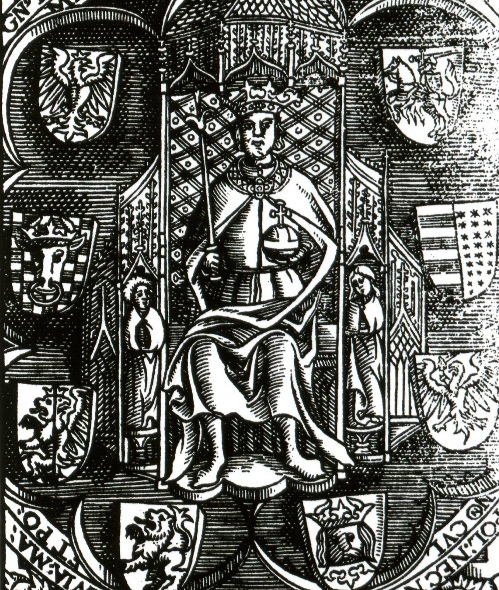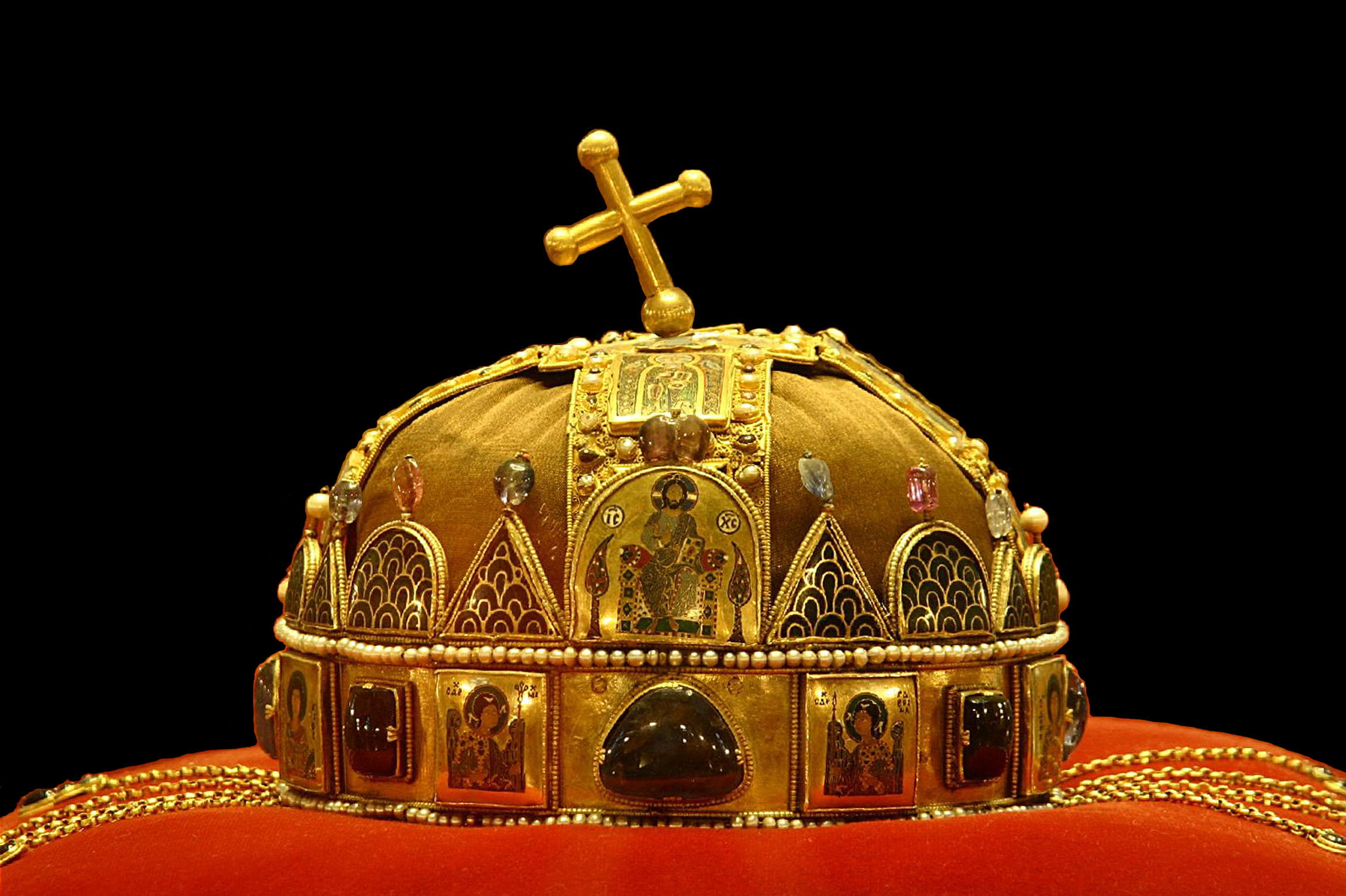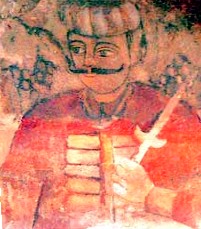|
Petru Aron
Peter III Aaron (; died 1467), bastard son of Alexandru cel Bun, was a Voivode (Prince) of Moldavia on three occasions: October 1451 to February 1452, August 1454 to February 1455, and May 1455 to April 1457. The first two were during a civil war with AlexńÉndrel. Background Peter Aaron ascended to the throne after assassinating Bogdan II, while the latter was at a wedding in Rauseni. Immediately, his rule was challenged by AlexńÉndrel, whom Peter managed to defeat in March 1455, forcing AlexńÉndrel to take refuge in the fortress at Cetatea AlbńÉ. Peter confirmed his father's commercial privileges awarded to Polish traders in Moldavia, and took an oath of vassalage to King Casimir IV. In 1456, Peter agreed to pay the Ottomans a tribute of 2,000 gold ducats, in order to ensure his southern borders, thus becoming the first of the Moldavian rulers to accept the Turkish demands. The real challenge to his throne came with Bogdan II's son Ňětefan cel Mare. The young prince ... [...More Info...] [...Related Items...] OR: [Wikipedia] [Google] [Baidu] |
List Of Rulers Of Moldavia
This is a list of monarchs of Moldavia, from the first mention of the medieval polity east of the Carpathian Mountains, Carpathians and until its disestablishment in 1862, when Unification of Moldavia and Wallachia, it united with Wallachia, the other Danubian Principalities, Danubian Principality, to form the modern-day state of Romania. Notes Dynastic rule is hard to ascribe, given the loose traditional definition of the ruling family (on principle, princes were chosen from any branch, including a previous monarch's bastard sons ‚Äď being defined as ''os de domn'' ‚Äď "of Hospodar, domn marrow", or as having ''hereghie'' ‚Äď "heredity" (from the Latin ''hereditas''); the institutions charged with the Elective monarchy, election, dominated by the boyars, had fluctuating degrees of influence). The system itself was challenged by usurpers, and became obsolete with the Phanariotes, Phanariote epoch, when monarchs were appointed by the Ottoman Empire, Ottoman Ottoman Dynasty, Sultans. ... [...More Info...] [...Related Items...] OR: [Wikipedia] [Google] [Baidu] |
Casimir IV Jagiellon
Casimir IV (Casimir Andrew Jagiellon; ; Lithuanian: ; 30 November 1427 ‚Äď 7 June 1492) was Grand Duke of Lithuania from 1440 and King of Poland from 1447 until his death in 1492. He was one of the most active Polish-Lithuanian rulers; under him, Poland defeated the Teutonic Knights in the Thirteen Years' War and recovered Pomerania. The Jagiellonian dynasty became one of the leading royal houses in Europe. The great triumph of his reign was bringing Prussia under Polish rule. The rule of Casimir corresponded to the age of "new monarchies" in western Europe. By the 15th century, Poland had narrowed the distance separating it from Western Europe and became a significant power in international relations. The demand for raw materials and semi-finished goods stimulated trade, producing a positive balance, and contributed to the growth of crafts and mining in the entire country. He was a recipient of the English Order of the Garter (KG), the highest order of chivalry and the most ... [...More Info...] [...Related Items...] OR: [Wikipedia] [Google] [Baidu] |
Battle Of Baia
The Battle of Baia (; ) was fought on December 15, 1467, between Moldavian prince Stephen the Great and the Hungarian king, Matthias Corvinus. Corvinus invaded Moldavia as a consequence of Stephen's annexation of Chilia‚ÄĒa fortress and harbour on the coast of the Black Sea‚ÄĒfrom Hungarian and Wallachian forces. It had belonged to Moldavia centuries earlier. Both sides claimed victory, but it was a ''de facto'' Moldavian victory since they managed to halt the Hungarian advance by injuring Matthias. Background In 1359, Bogdan I of Moldavia rebelled against the King of Hungary and founded an independent Moldavia. However, the Hungarian attempts to seize control over Moldavia did not end there, and in 1429, Sigismund, Holy Roman Emperor, and also King of Hungary, met with WŇāadysŇāaw JagieŇāŇāo, King of Poland to try to persuade him to launch a common attack on Moldavia and divide the country in two equal parts‚ÄĒPolish and Hungarian.DŇāugosz, p. 449 Sigismund argued that t ... [...More Info...] [...Related Items...] OR: [Wikipedia] [Google] [Baidu] |
Matthias Corvinus Of Hungary
Matthias Corvinus (; ; ; ; ; ) was King of Hungary and Croatia from 1458 to 1490, as Matthias I. He is often given the epithet "the Just". After conducting several military campaigns, he was elected King of Bohemia in 1469 and adopted the title Duke of Austria in 1487. He was the son of John Hunyadi, Regent of Hungary, who died in 1456. In 1457, Matthias was imprisoned along with his older brother, Ladislaus Hunyadi, on the orders of King Ladislaus the Posthumous. Ladislaus Hunyadi was executed, causing a rebellion that forced King Ladislaus to flee Hungary. After the King died unexpectedly, Matthias's uncle Michael Szil√°gyi persuaded the Estates to unanimously proclaim the 14-year-old Matthias as king on 24 January 1458. He began his rule under his uncle's guardianship, but he took effective control of government within two weeks. As king, Matthias waged wars against the Czech mercenaries who dominated Upper Hungary (today parts of Slovakia and Northern Hungary) and ag ... [...More Info...] [...Related Items...] OR: [Wikipedia] [Google] [Baidu] |
List Of Hungarian Rulers
This is a list of Hungarian monarchs; it includes the Grand Prince of the Hungarians, grand princes (895‚Äď1000) and the King of Hungary, kings and ruling queens of Hungary (1000‚Äď1918). The Principality of Hungary, Hungarian Grand Principality was established around 895, following the 9th-century Hungarian conquest of the Carpathian Basin. The Kingdom of Hungary existed from 1000‚Äď1001 with the coronation of King Saint Stephen. The √Ārp√°d dynasty, the male-line descendants of Grand Prince √Ārp√°d, ruled Hungary continuously from 895 to 1301. Christianity was adopted as the state religion for the Kingdom of Hungary by King Stephen I of Hungary, Saint Stephen and the kings of the √Ārp√°d dynasty used the title of the Apostolic Majesty, apostolic king. The descendants of the dynasty gave the world the highest number of saints and blesseds from one family. Therefore, since the 13th century the dynasty has often been referred to as the "Kindred of the Holy Kings". The √Ārp√°d dynast ... [...More Info...] [...Related Items...] OR: [Wikipedia] [Google] [Baidu] |
Wallachia
Wallachia or Walachia (; ; : , : ) is a historical and geographical region of modern-day Romania. It is situated north of the Lower Danube and south of the Southern Carpathians. Wallachia was traditionally divided into two sections, Muntenia (Greater Wallachia) and Oltenia (Lesser Wallachia). Dobruja could sometimes be considered a third section due to its proximity and brief rule over it. Wallachia as a whole is sometimes referred to as Muntenia through identification with the larger of the two traditional sections. Wallachia was founded as a principality in the early 14th century by Basarab I after a rebellion against Charles I of Hungary, although the first mention of the territory of Wallachia west of the river Olt dates to a charter given to the voivode Seneslau in 1246 by Béla IV of Hungary. In 1417, Wallachia was forced to accept the suzerainty of the Ottoman Empire; this lasted until the 19th century. In 1859, Wallachia united with Moldavia to form the Un ... [...More Info...] [...Related Items...] OR: [Wikipedia] [Google] [Baidu] |
List Of Wallachian Rulers
This is a list of princes of Wallachia, from the first mention of a medieval polity situated between the Southern Carpathians and the Danube until the union with Moldavia in 1859, which led to the creation of Romania. Notes Dynastic rule is hard to ascribe, given the loose traditional definition of the ruling family. On principle, princes were chosen from any family branch, including a previous ruler's bastard sons, being defined as ''os de domn'', "of Voivode marrow", or as having ''heregie'', "heredity" (from the Latin ''hereditas''); the institutions charged with the election, dominated by the boyars, had fluctuating degrees of influence. The system itself was challenged by usurpers, and became obsolete with the Phanariote epoch, when rulers were appointed by the Ottoman Sultans; between 1821 and 1878 (the date of Romania's independence), various systems combining election and appointment were put in practice. Wallachian rulers, like the Moldavian rulers, bore the titles of ' ... [...More Info...] [...Related Items...] OR: [Wikipedia] [Google] [Baidu] |
Vlad III Dracula
Vlad III, commonly known as Vlad the Impaler ( ) or Vlad Dracula (; ; 1428/31 ‚Äď 1476/77), was Voivode of Wallachia three times between 1448 and his death in 1476/77. He is often considered one of the most important rulers in Wallachian history and a national hero of Romania. He was the second son of Vlad Dracul, who became the ruler of Wallachia in 1436. Vlad and his younger brother, Radu, were held as hostages in the Ottoman Empire in 1442 to secure their father's loyalty. Vlad's eldest brother Mircea and their father were murdered after John Hunyadi, regent-governor of Hungary, invaded Wallachia in 1447. Hunyadi installed Vlad's second cousin, VladislavII, as the new voivode. Hunyadi launched a military campaign against the Ottomans in the autumn of 1448, and Vladislav accompanied him. Vlad broke into Wallachia with Ottoman support in October, but Vladislav returned, and Vlad sought refuge in the Ottoman Empire before the end of the year. Vlad went to Moldavia in 1449 ... [...More Info...] [...Related Items...] OR: [Wikipedia] [Google] [Baidu] |
John Hunyadi
John Hunyadi (; ; ; ; ; ‚Äď 11 August 1456) was a leading Kingdom of Hungary, Hungarian military and political figure during the 15th century, who served as Regent of Hungary, regent of the Kingdom of Hungary (1301‚Äď1526), Kingdom of Hungary from 1446 to 1453, under the minor Ladislaus the Posthumous, Ladislaus V. According to most contemporary sources, he was the member of a Nobility in the Kingdom of Hungary, noble family of Principality of Wallachia, Wallachian Hunyadi family, ancestry. Through his struggles against the Ottoman Empire, he earned for himself the nickname "Turk-buster" from his contemporaries. Due to his merits, he quickly received substantial land grants. By the time of his death, he was the owner of immense land areas, totaling approximately four million cadastral acres, which had no precedent before or after in the Kingdom of Hungary. His enormous wealth and his military and political weight were primarily directed towards the purposes of the Hungarian‚Äď ... [...More Info...] [...Related Items...] OR: [Wikipedia] [Google] [Baidu] |
Kingdom Of Hungary
The Kingdom of Hungary was a monarchy in Central Europe that existed for nearly a millennium, from 1000 to 1946 and was a key part of the Habsburg monarchy from 1526-1918. The Principality of Hungary emerged as a Christian kingdom upon the Coronation of the Hungarian monarch, coronation of the first king Stephen I of Hungary, Stephen I at Esztergom around the year 1000;Krist√≥ Gyula ‚Äď Barta J√°nos ‚Äď Gergely JenŇĎ: Magyarorsz√°g t√∂rt√©nete elŇĎidŇĎktŇĎl 2000-ig (History of Hungary from the prehistory to 2000), Pannonica Kiad√≥, Budapest, 2002, , pp. 37, 113, 678 ("Magyarorsz√°g a 12. sz√°zad m√°sodik fel√©re jelentŇĎs eur√≥pai t√©nyezŇĎv√©, k√∂z√©phatalomm√° v√°lt."/"By the 12th century Hungary became an important European factor, became a middle power.", "A Nyugat r√©sz√©v√© v√°lt Magyarorsz√°g.../Hungary became part of the West"), pp. 616‚Äď644 his family (the √Ārp√°d dynasty) led the monarchy for 300 years. By the 12th century, the kingdom became a European power. Du ... [...More Info...] [...Related Items...] OR: [Wikipedia] [Google] [Baidu] |
Ňětefan Cel Mare
Stephen III, better known as Stephen the Great (; ; died 2 July 1504), was Voivode (or Prince) of Moldavia from 1457 to 1504. He was the son of and co-ruler with Bogdan II, who was murdered in 1451 in a conspiracy organized by his brother and Stephen's uncle Peter III Aaron, who took the throne. Stephen fled to Hungary, and later to Wallachia; with the support of Vlad III »öepe»ô, Voivode of Wallachia, he returned to Moldavia, forcing Aaron to seek refuge in Poland in the summer of 1457. Teoctist I, Metropolitan of Moldavia, anointed Stephen prince. He attacked Poland and prevented Casimir IV Jagiellon, King of Poland, from supporting Peter Aaron, but eventually acknowledged Casimir's suzerainty in 1459. Stephen decided to recapture Chilia (now Kiliia in Ukraine), an important port on the Danube, which brought him into conflict with Hungary and Wallachia. He besieged the town during the Ottoman invasion of Wallachia in 1462, but was seriously wounded during the siege. Two y ... [...More Info...] [...Related Items...] OR: [Wikipedia] [Google] [Baidu] |








